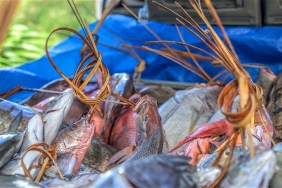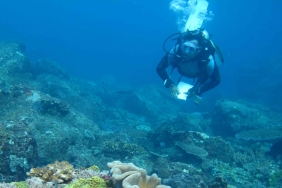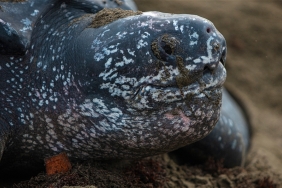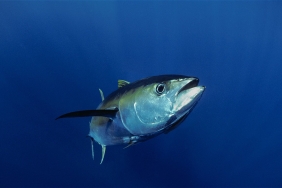TWO SHARK NURSERY SITES TAGGED IN WEST MANGGARAI
By: Euis Zulfiaty (Bycatch and Shark Conservation Program Assistant, WWWF-Indonesia)
There were nine shark pups caught in the bottom net of Mr. Aja, a fisherman from Rangko Village, Boleng District, West Manggarai. These nine blackspot tail shark (Carchahinus sorrah) were found dead with the net caught on the snout and some entangled on the body.
The sharks were pups with an average length of 70 - 80 cm, consisting of 4 males and 5 females. Ideally, the black spot tail shark, which is called a mackerel shark by the people of Rangko Village, matures to a size of 103 -115 cm for males and 110-118 cm for females.
One black spot tail shark mother has an average number of 6 - 10 pups. This means that in one night, one fishing gear in one location has the potential to produce shark bycatch from one shark broodstock.
Since the catch data collection in March 2017 by the West Manggarai Food Security and Fisheries Office (DKPP) at Ketentang Landing, WWF and DKPP Mabar started the socialization of the Better Management Practices (BMP) Guidelines for Handling Sharks as Bycatch (Bycatch) on May 10, 2017. This is the first time for Rangko Village to be assisted by WWF-Indonesia for the implementation of BMPs.
That day (7/8/17), we operated not far from the village, only about fifteen minutes to get to the net marking buoy. The cluster of hills of mainland Flores forms like a bay. Between Rangko Village and Batu Dua Island, a 450-meter-long net stretches to block the current from the open ocean to the mainland.
Thus, fish that are looking for food at night can easily get entangled in the net. The waters of the islands are rough, with muddy bottoms that are favored habitats for black spot tail sharks.
Mr. Budi and Darsono, two of Mr. Aja's crew members, continue to roll the net using a manual winder that has been designed to make it easier to set and haul the net.
"I chose this basic trawl to catch fish because it catches large fish that weigh five to tens of kilograms, such as mackerel, kuwe, and milkfish," explained Mr. Aja. "This trawl is quite profitable because operating it does not recognize the fishing season," he added as an excuse.
The trawl, which is operated at the bottom of the water with a depth of up to 20-30 meters, has a mesh size of 4 inches. So that the catch obtained is of course large fish. Although they have tried to be selective to avoid small-sized consumable fish, it turns out that the capture of sharks is unavoidable.
Mr. Budi said that they did not intend to catch sharks, but very often small sharks get caught in the net. In fact, during the west season from October to March, the number of sharks caught can reach 40 to 80 in one night. Some are alive and some are dead.
"The western season with cold weather makes many fish venture into shallow waters in search of warm water temperatures. High wave conditions and murky waters make many fish stuck in the net," said Mr. Aja during his 37 years of experience as a fisherman.
As assisted by WWF-Indonesia, Rangko fishermen are equipped with knowledge about preventive measures, such as choosing catch locations that are free from shark nursery areas, shark spawning seasons, and choosing the right mesh size. Fishermen are also encouraged to release sharks that are still alive.
During the mentoring period, two locations of shark pups have been GPS tagged. In the future, this data can also serve as a reference for the management of marine protected areas (MPAs) for sharks. The assistance can also be complemented with the introduction of shark bycatch mitigation tools, so that fishermen are more vigilant and sharks remain sustainable.





